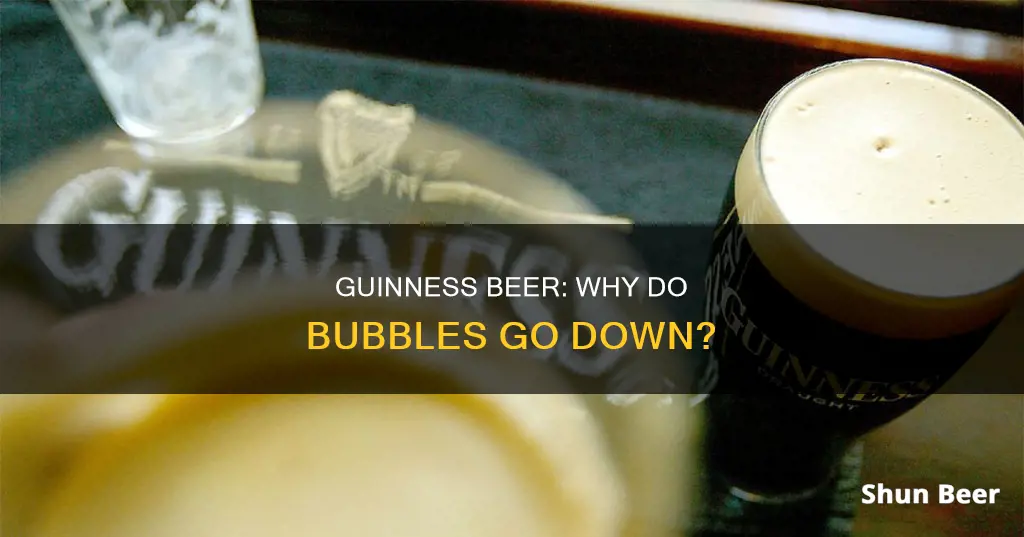
The bubbles in Guinness beer appear to sink, which is puzzling given that bubbles in other liquids rise to the top. This phenomenon is due to a combination of the shape of the glass, the size of the bubbles, and the type of gas in the beer. Firstly, the shape of a standard pint glass creates areas of varying bubble density, with high density in the center and low density along the edges. The bubbles in the center rise rapidly, pushing the surrounding liquid upwards. This liquid then hits the surface and flows outward, creating a downward current along the edges of the glass that pulls the small bubbles hanging around the edges down with it. Additionally, Guinness beer contains nitrogen gas, which does not dissolve as well in liquid compared to carbon dioxide, the gas found in most lager beers. This results in smaller bubbles that are more easily pushed around by the flowing liquid, contributing to the appearance of sinking bubbles.
| Characteristics | Values |
|---|---|
| Bubble movement | Downwards |
| Bubble size | Small |
| Bubble creation | Released at high pressure through fine holes |
| Gas in bubbles | Nitrogen |
| Glass shape | Pint glass |
| Bubble density | High in the middle, low on the edges |
What You'll Learn

Nitrogen bubbles are smaller and less prone to growth
The small size of nitrogen bubbles is due to the fact that they are released at high pressure through fine holes when poured from a tap or from the "widget" in a can or bottle. The high pressure forces the nitrogen out of the beer and into bubbles. The bubbles are so small that they are roughly the size of a human hair. Their tiny size makes them more susceptible to drag forces and easier to push around with a flowing liquid.
The shape of the glass also plays a role in the downward movement of bubbles. In a typical pint glass, which widens towards the top, the rising motion of bubbles creates a clear-fluid (bubble-free) film above the inclined wall. This film falls downward, while the bubble-rich bulk rises. This is known as the Boycott effect. The combination of the glass shape and the small, nitrogen-filled bubbles creates a circulation in the glass, with bubbles rising in the center and being pushed downward along the edges.
The phenomenon of bubbles appearing to sink in Guinness is not unique to this beer, but its distinct dark color and light-colored cream bubbles make it easier to observe. Overall, the small size and slower growth of nitrogen bubbles, combined with the shape of the glass, contribute to the unique bubble dynamics seen in Guinness beer.
The Irish Heritage of Guinness Beer
You may want to see also

Glass shape creates areas of low and high bubble density
The shape of the glass has a significant impact on the bubble density in Guinness beer. Typically, pint glasses are narrower at the bottom and wider at the top, which creates areas of varying bubble density. This unique shape causes the beer to flow downward near the walls of the glass and upward in the interior, resulting in a circulatory pattern that leads to the formation of a creamy white head of foam.
Dr. William Lee, a former Professor of Applied Mathematics at the University of Limerick, conducted experiments to investigate the effect of glass shape on bubble behaviour. He poured Guinness into a normal pint glass and an anti-pint glass with a wider base. In the normal pint glass, the bubbles near the sides sank to the bottom, while in the anti-pint glass, they rose. This observation led to the conclusion that the shape of a normal pint glass creates areas of low bubble density along the edges and high bubble density in the centre.
The specific geometry of pint glasses, with their wider tops, contributes to the formation of a clear-fluid (bubble-free) film above the inclined wall. This is known as the Boycott effect. The dense clear-fluid film falls, while the bubble-rich bulk rises, resulting in the downward motion of bubbles observed in Guinness beer.
While the glass shape plays a crucial role in bubble behaviour, it is not the only factor. The small size of the nitrogen bubbles in Guinness, which are about a tenth of the size of those in Budweiser or Champagne, also contributes to their downward movement. Additionally, the fluid dynamics of the beer and the upward flow of bubbles in the centre of the glass are important factors in creating the circulation pattern.
Guinness Beer: Carcinogen Concerns and Consumption
You may want to see also

Bubbles experience drag along the glass
The bubbles in a pint of Guinness appear to sink, rather than floating to the top as they do in other beers. This phenomenon has puzzled beer drinkers for a long time. It turns out that the bubbles in Guinness do not actually sink, but they do experience drag along the glass, which causes them to be pushed downwards.
When Guinness is poured, the bubbles touch the walls of the glass and experience drag, similar to the sensation you feel when sliding your finger along a glass surface. In the centre of the glass, the bubbles are free to rise rapidly, as they naturally do in a liquid. As they rise, they push and pull the surrounding liquid with them. When they reach the top, this liquid hits the surface and flows outwards towards the edges of the glass. The current is then directed downwards by the edges of the glass, creating a circular flow. This flow pushes the bubbles that are near the edges of the glass downwards, while more bubbles flow upwards in the centre, creating a continuous circulation.
The shape of the glass plays a crucial role in this phenomenon. In a typical pint glass, which narrows near its base, the bubbles on the sides of the glass experience greater drag and are pulled downwards. On the other hand, in an anti-pint glass, which widens near its base, the bubbles near the sides experience less drag and begin to rise.
The unique properties of Guinness also contribute to the visibility of this effect. Firstly, the bubbles in Guinness are smaller than in other beers because they are released at high pressure through fine holes when poured from a tap or from the "widget" in a can. These small bubbles are more easily pushed around by the flowing liquid, creating a more noticeable downward motion. Additionally, the gas in Guinness bubbles is primarily nitrogen, which does not dissolve as well in liquid as carbon dioxide, the gas found in most lager beers. As a result, Guinness bubbles do not grow as large as those in lager. Finally, the contrast between the dark liquid and the light cream-coloured bubbles in Guinness makes the waves and bubbles more obvious to the observer.
The Harp: Guinness Beer's Musical Label Identity
You may want to see also

Circulation is created by bubbles rising in the centre
The bubbles in Guinness beer sink due to a combination of the gas used, and the shape of the glass.
The circulation of bubbles in Guinness beer is primarily caused by the rising of bubbles in the centre of the glass. This movement creates a current of beer that pulls the bubbles downwards, which then circulate back upwards. The bubbles in the centre are free to rise rapidly, as they naturally do in any liquid, creating a circulation. This circulation causes the bubbles at the edge of the glass to be pushed downwards.
The bubbles in Guinness are small due to being released at high pressure through fine holes when poured from a tap or can. The gas in these bubbles is nitrogen, which does not dissolve as well in liquid as carbon dioxide, the gas found in most lager beers and sodas. This means that the bubbles in Guinness do not grow in the same way as those in lager or soda. The small size of the bubbles also makes them more susceptible to drag, and easier to push around with flowing liquid.
The shape of the glass also plays a role in the circulation of bubbles. In a typical pint glass, which narrows towards the base, bubbles on the sides of the glass sink to the bottom. However, in an anti-pint glass, which widens towards the base, bubbles near the sides rise. This is because the shape of the pint glass creates areas of low bubble density along the edges and areas of high bubble density in the middle.
Guinness Beer's Ball: A Unique Brewing Mystery
You may want to see also

The phenomenon can be observed in other liquids
The phenomenon of bubbles flowing downwards in a glass of Guinness is not unique to the beverage. It can be observed in other liquids as well, including other draught-flow beers like Boddingtons. This can be demonstrated by using a "bubble-maker", which is a tube with fine holes at the end that releases gas to create small bubbles in a glass of plain water. The bubbles will rise up in the centre of the glass and create a circular flow, pushing the bubbles at the inside edge near the top downwards.
Additionally, the downward flow of bubbles can be observed in water with a fizzing tablet added to it. While these bubbles may not be easily visible to the naked eye, they can be seen using a fast camera. Another way to visualise this flow is by using a suspension of powder in liquid, known as a rheoscopic fluid, which can be purchased at science or teacher supply stores.
The downward bubble phenomenon is not limited to beverages but can also be observed in other liquids with different viscosities, such as syrup. The viscosity of Guinness is only slightly different from that of water, so it does not significantly impact the movement of the bubbles.
The shape of the glass also plays a role in this phenomenon. It has been found that the downward flow of bubbles occurs in both curved and straight glasses, although the pattern of flow may vary depending on the shape.
Guinness: A Dessert Beer? Exploring the Unique Taste of Guinness
You may want to see also







